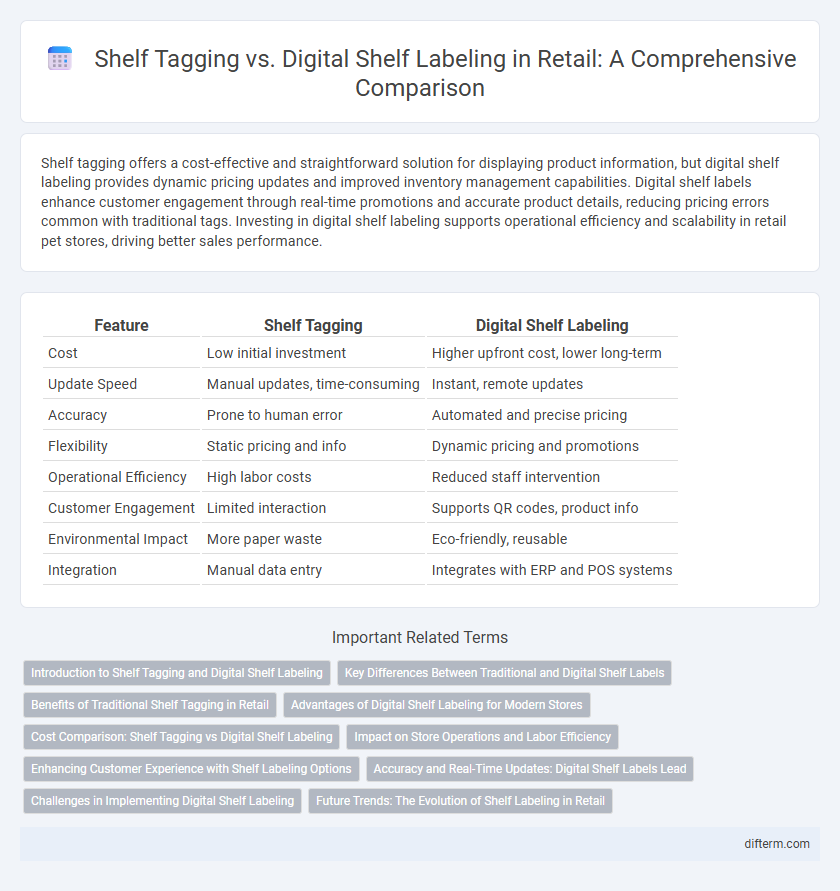Shelf tagging offers a cost-effective and straightforward solution for displaying product information, but digital shelf labeling provides dynamic pricing updates and improved inventory management capabilities. Digital shelf labels enhance customer engagement through real-time promotions and accurate product details, reducing pricing errors common with traditional tags. Investing in digital shelf labeling supports operational efficiency and scalability in retail pet stores, driving better sales performance.
Table of Comparison
| Feature | Shelf Tagging | Digital Shelf Labeling |
|---|---|---|
| Cost | Low initial investment | Higher upfront cost, lower long-term |
| Update Speed | Manual updates, time-consuming | Instant, remote updates |
| Accuracy | Prone to human error | Automated and precise pricing |
| Flexibility | Static pricing and info | Dynamic pricing and promotions |
| Operational Efficiency | High labor costs | Reduced staff intervention |
| Customer Engagement | Limited interaction | Supports QR codes, product info |
| Environmental Impact | More paper waste | Eco-friendly, reusable |
| Integration | Manual data entry | Integrates with ERP and POS systems |
Introduction to Shelf Tagging and Digital Shelf Labeling
Shelf tagging involves the use of physical labels attached to store shelves to display product information, pricing, and promotions, providing clear and immediate information to customers. Digital shelf labeling replaces paper tags with electronic displays, enabling real-time updates, dynamic pricing, and enhanced accuracy while reducing labor costs. Both methods aim to improve retail efficiency and enhance the shopping experience, but digital shelf labeling offers greater flexibility and integration with inventory management systems.
Key Differences Between Traditional and Digital Shelf Labels
Traditional shelf tagging uses printed paper or plastic labels that require manual updates, leading to higher labor costs and slower price adjustments. Digital shelf labeling employs electronic ink or LCD screens, enabling real-time price changes, dynamic promotions, and better inventory management through centralized software. The shift to digital labeling reduces errors, enhances customer engagement, and improves operational efficiency in retail environments.
Benefits of Traditional Shelf Tagging in Retail
Traditional shelf tagging in retail offers cost-effective implementation with minimal technological requirements, making it accessible for small to medium-sized stores. These tags provide straightforward, clear product information that reduces customer confusion and enhances the shopping experience. Shelf tags also allow for quick manual updates, aiding staff in maintaining accurate pricing and promotions without reliance on digital systems.
Advantages of Digital Shelf Labeling for Modern Stores
Digital shelf labeling enhances retail efficiency by enabling real-time price updates and seamless inventory management, reducing labor costs and minimizing pricing errors. This advanced technology improves customer experience through clear, dynamic displays that can integrate promotions and product information instantly. Modern stores benefit from increased operational agility, improved accuracy, and the ability to quickly adapt to market changes with digital shelf labels.
Cost Comparison: Shelf Tagging vs Digital Shelf Labeling
Shelf tagging incurs lower initial costs as it involves inexpensive printed labels but requires frequent manual updates, increasing labor expenses over time. Digital shelf labeling demands a higher upfront investment in electronic displays and software but reduces long-term operational costs through automated pricing updates and error minimization. Retailers balancing budget constraints and scalability often evaluate the total cost of ownership, considering the efficiency gains and accuracy offered by digital shelf labeling against the simplicity and low entry cost of traditional shelf tagging.
Impact on Store Operations and Labor Efficiency
Shelf tagging requires manual updates, which increases labor costs and risks of human error, directly impacting store operations by slowing down price changes and promotions. Digital shelf labeling automates price updates and product information in real-time, significantly reducing labor intensity and improving accuracy, which streamlines operations and enhances overall workforce productivity. Implementing digital shelf labels enables retailers to optimize labor allocation, accelerate response times to market changes, and maintain consistent pricing across all products.
Enhancing Customer Experience with Shelf Labeling Options
Shelf tagging provides clear product information and pricing, helping customers make quick decisions in-store while maintaining low implementation costs. Digital shelf labeling offers dynamic pricing updates, real-time promotions, and enhanced visual appeal, driving customer engagement and reducing pricing errors. Integrating both methods can optimize the retail environment, balancing efficiency and interactive shopping experiences to elevate overall customer satisfaction.
Accuracy and Real-Time Updates: Digital Shelf Labels Lead
Digital shelf labeling ensures superior accuracy by instantly reflecting price changes, promotions, and product information, eliminating human errors common in traditional shelf tagging. Real-time updates empower retailers to respond swiftly to market demands and inventory fluctuations, enhancing operational efficiency and customer satisfaction. Advanced electronic shelf labels integrate seamlessly with inventory management systems, providing dynamic and precise data that traditional paper tags cannot match.
Challenges in Implementing Digital Shelf Labeling
Implementing digital shelf labeling in retail faces challenges such as high upfront costs, integration complexities with existing inventory systems, and ensuring reliable wireless connectivity throughout the store. Retailers must address durability concerns of electronic labels in varied environmental conditions and manage frequent updates to pricing and product information without causing disruptions. Overcoming these obstacles requires strategic investment and robust technology infrastructure to fully leverage the benefits of digital shelf labeling.
Future Trends: The Evolution of Shelf Labeling in Retail
Shelf tagging is evolving with the integration of digital shelf labeling, leveraging IoT and real-time data to enhance price accuracy and inventory management in retail. Future trends emphasize AI-driven dynamic pricing, interactive displays, and seamless integration with mobile apps to personalize customer experiences. Digital shelf labels reduce operational costs and enable retailers to respond swiftly to market changes, driving efficiency and boosting sales.
Shelf Tagging vs Digital Shelf Labeling Infographic

 difterm.com
difterm.com